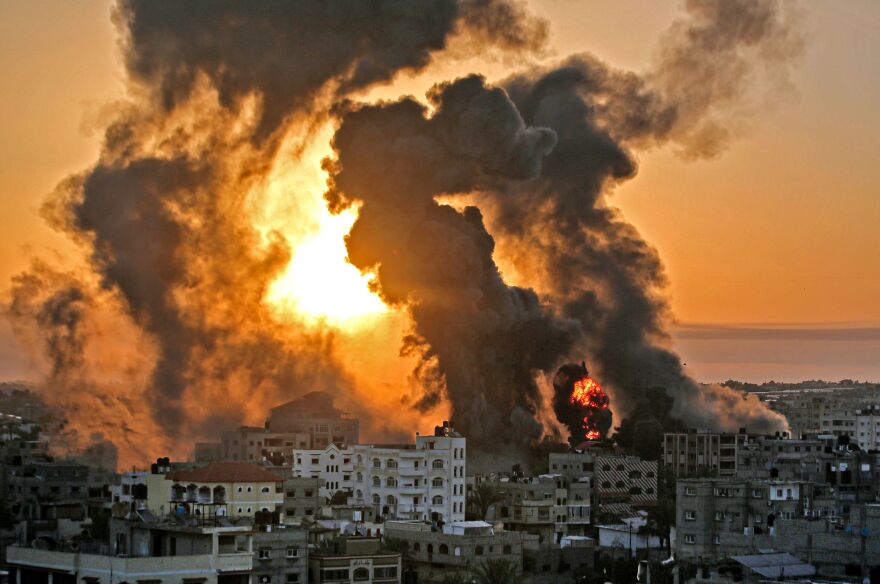Updated May 20, 2021 at 4:29 PM ET
Tensions boil over in Jerusalem. Hamas fires rockets from Gaza into Israel. Israel unleashes its heavy firepower, causing casualties and destruction. Then it all repeats again and again. It is a familiar, devastating cycle of violence that has prompted protests around the world.
On Thursday, Israel's government announced a cease-fire after 11 days of fighting with Hamas. If the agreement holds, it will end the heaviest round of fighting since 2014.
Israel's bombardments in Gaza have left more than 200 Palestinians dead, according to the territory's Health Ministry, and toppled large buildings and displaced many families.
Most of Hamas' rockets are intercepted by Israeli defenses. But the attacks force Israelis to take shelter, and the rockets that get through have killed 12 people and caused damage.
The fighting is rooted in the decades-old Israeli-Palestinian conflict and comes after Israel and Hamas have fought several wars in the past decade and a half. Hamas is an Islamist movement that's designated a terrorist group by Israel, the United States and many European countries.
This year, the International Criminal Court launched an investigation into possible war crimes committed by Israel and Palestinian militants during the last round of heavy fighting in Gaza, in 2014. The court has warned that the latest fighting could be investigated as well.
Here is a look at some key events in the Israel-Hamas conflict:
September 2005
Israel withdraws settlements and military personnel from the Gaza Strip, which it began to occupy after capturing the territory during the 1967 Six-Day War.
January 2006
Hamas wins an overwhelming victory in Palestinian parliamentary elections, sparking a struggle for primacy with its rival, the Fatah movement led by Mahmoud Abbas, who remains president of the Palestinian Authority to this day. Fatah is much stronger in the West Bank, while Hamas is the main power in Gaza.
That June, Hamas militants cross a tunnel from Gaza and attack an Israeli military base, killing two Israeli soldiers and capturing service member Gilad Shalit. Israel invades Gaza.
June 2007
Hamas violently ousts Fatah forces from the Gaza Strip and solidifies its control of the territory. Israel and Egypt tighten their blockade of Gaza, which will devastate Gaza's economy over the next decade. Two rival governments emerge: Hamas in Gaza and Abbas' Palestinian Authority in the West Bank.
December 2008
In response to heavy rocket fire from Gaza, Israel launches a major three-week offensive. After a 22-day war that kills 1,200 Palestinians and 13 Israelis, the two sides announce a cease-fire.
March 2009
Benjamin Netanyahu, leader of the Likud party, becomes prime minister of Israel a second time. His long tenure eventually emboldens Israeli religious nationalists, accelerating settlement expansion and signaling opposition to a two-state solution to the Israeli-Palestinian conflict.
October 2011
Hamas releases Shalit, the Israeli soldier it captured in the 2006 raid. Israel releases the first group of what will be more than 1,000 freed Palestinian prisoners.
Also in 2011, Israel's Iron Dome missile defense system becomes active and effectively blocks its first rocket from Gaza.
November 2012
Israel kills Hamas military chief Ahmed Jabari, sparking eight days of militant rocket fire from Gaza and an Israeli air campaign. Egyptian mediators secure a cease-fire after some 150 Palestinians and six Israelis are killed.

July-August 2014
Following the kidnapping and killing of three Israeli teenagers by Hamas members, Israel conducts a sweep against Hamas in the West Bank, prompting rocket attacks from Gaza and Israeli air raids. The seven-week conflict that ensues results in more than 2,200 Palestinian deaths in Gaza, more than half of them civilians. In Israel, 67 soldiers and six civilians are killed. Israel comes under heavy international criticism for its use of what the United Nations calls disproportionate force.
December 2017
President Donald Trump recognizes Israel's claim to Jerusalem as its capital and directs the State Department to move the U.S. Embassy there. Palestinians seek part of Jerusalem for their capital. Hamas calls for a Palestinian uprising.
March 2018
Along the Gaza perimeter fence, Palestinian protesters, led by Hamas, stage massive demonstrations against the blockade of Gaza. Although mostly unarmed, many protesters burn tires, throw rocks and grenades at Israeli troops and damage the perimeter fence. Israeli troops kill more than 170 protesters over a period of several months. Israel says it is defending its border but is accused of using excessive force. Israel and Hamas engage in a number of rounds of intense but brief fighting during this time.

November 2018
Violence flares up after an Israeli undercover raid into Gaza kills seven Palestinian militants and a senior Israeli army officer, marking the most serious escalation since the war in 2014. Gaza militants fire hundreds of rockets at Israel, killing a Palestinian laborer in southern Israel. At least seven Palestinians, among them five militants, are killed in Gaza.
March 2021
The International Criminal Court opens an investigation into alleged crimes by Israelis and Palestinians since 2014.
May 2021
Hamas fires long-range rockets toward Jerusalem in support of Palestinian protests against Israel's heavy-handed policing of the Al-Aqsa Mosque compound in Jerusalem and the threatened eviction of dozens of Palestinian families by Jewish settlers. Israel launches airstrikes on Gaza. The Israel Defense Forces say 3,750 rockets are fired from Gaza at Israel, 90% of them intercepted. Israel steps up its aerial assaults in densely populated Gaza, toppling high-rise buildings and killing 230 Palestinians, according to the Hamas-run Health Ministry. Israel says militants' rockets kill 12 people in Israel. On May 20, the Israeli prime minister's office announces a cease-fire.
This story is based on a timeline by The Associated Press along with information from a variety of news and research sources.
Copyright 2023 NPR. To see more, visit https://www.npr.org.



